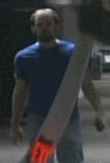|
|
This topic comprises 5 pages: 1 2 3 4 5
|
|
Author
|
Topic: Threading Projectors- top/bottom or bottom/top (revisited)
|
|
|
|
|
|
|
|
|
|
|
|
|
|
|
Joe Redifer
You need a beating today

Posts: 12859
From: Denver, Colorado
Registered: May 99
|
 posted 12-15-2003 08:00 AM
posted 12-15-2003 08:00 AM





I used to thread top to bottom forever. I was trained that way, but fortunately I didn't believe that just because that's the way I learned that it was the best way. I started threading bottom to top, and while it took a short time to get used to, my threading is quicker and far more accurate. Plus the first thing that shows on the screen is cleaner.
Think about it: First set the intermittent right where it needs to be. You pull the film to engage the take up platter FIRST, and then pull the film to the holdback sprocket. Then thread UP, pulling more film from the payout deck as you go. It is so much easier it is not even funny. It's WAY more natural, and you thread with consistent loop sizes each and every time. When threading top to bottom, you'll usually have to go back and adjust a loop size or two. That' a waste of time.
I was able to try it a new way. Are you? And don't just try it once and say "Arg I'm not used to this I can't handle it I quit!". I've never seen anyone who threaded bottom up want to thread top down ever again. I forced a bunch of projectionists who were used to threadin top down to thread bottom up, and now they teach others to thread bottom up.
Anyone who takes pride in their work will want to o it the best way, and this is the best way, hands down. If you disagree, you are wrong.
| IP: Logged
|
|
|
|
|
|
|
|
|
|
|
|
|
|
|
|
|
|
All times are Central (GMT -6:00)
|
This topic comprises 5 pages: 1 2 3 4 5
|
Powered by Infopop Corporation
UBB.classicTM
6.3.1.2
The Film-Tech Forums are designed for various members related to the cinema industry to express their opinions, viewpoints and testimonials on various products, services and events based upon speculation, personal knowledge and factual information through use, therefore all views represented here allow no liability upon the publishers of this web site and the owners of said views assume no liability for any ill will resulting from these postings. The posts made here are for educational as well as entertainment purposes and as such anyone viewing this portion of the website must accept these views as statements of the author of that opinion
and agrees to release the authors from any and all liability.
|

 Home
Home
 Products
Products
 Store
Store
 Forum
Forum
 Warehouse
Warehouse
 Contact Us
Contact Us




 Printer-friendly view of this topic
Printer-friendly view of this topic


















